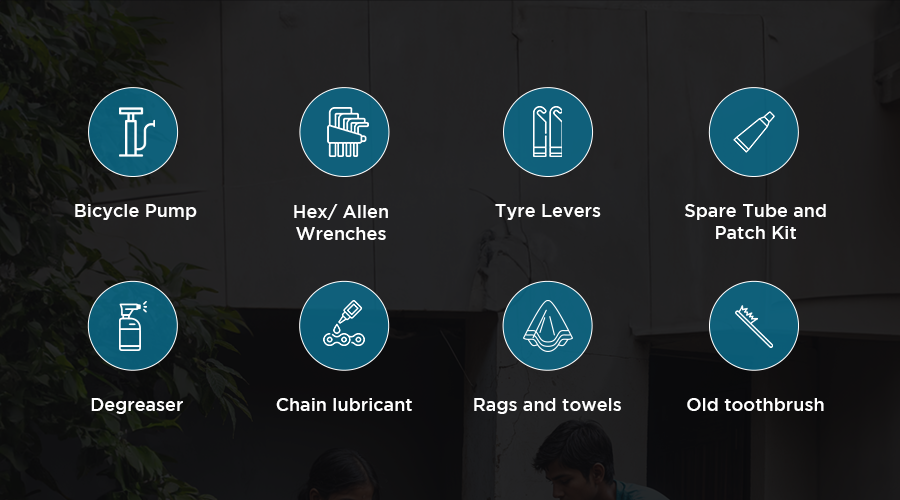Author: Priyanka Krishnan, Research & Program Associate, B.MOBILE, B.PAC
Co-Authors: Nayana Sharma P and Mitushee Sawarkar, Interns, B.PAC
It’s World Bicycle Day 2024, and I wonder if we keep chores like bicycle and fan maintenance on the same pedestal as that of car, motorbike or air-conditioner maintenance. Maybe we are more afraid of spoiling the pricier things, which is quite understandable. But come to think of it, cycling helps us stay fit while on the move. There is a sense of calmth and freedom as one cycles.
Maintaining your bicycle in top form is crucial for safe and comfortable rides. Below is an easy Bicycle maintenance guide:
ABC Quick Check (before every ride):
1. Air: Check the tyre pressure and inflate them to the recommended PSI listed on the tire sidewall. Usually town/hybrid bicycle are inflated to 60 PSI, road/racing bicycles to 100 PSI, mountain bicycles to 40 PSI.
2. Brakes: Press the brakes to ensure that they are responsive and not rubbing against the rims. Squeaky brakes occur when brake pads are worn or not aligned properly.
3. Chain: Check for any excessive wear, rust, or grime. Clean and lubricate if required.
Basic supplies and tools for maintenance:
● Bicycle Pump: A good quality pump to inflate tyres to the correct pressure is crucial for safety and performance. Look for a pump that is compatible with your valve type.
● Hex/ Allen Wrenches: L-shaped tools that are used for driving or loosening bolts and screws with a hexagonal socket. This works on most bicycles. A good set will typically range from 2mm to 10mm.
● Tyre Levers: These pry tools help remove a tyre from the rim when fixing a flat tire.
● Spare Tube and Patch Kit: Patch kits include patches, sandpaper (to rough up the surface of the tube for better adhesion), and rubber cement to repair a punctured inner tube.
● Degreaser
● Chain lubricant
● Rags and towels
● Old toothbrush
Weekly maintenance of a bicycle :
● Cleaning: Regularly clean your bicycle with mild soapy water in order to remove grime and dirt. Pay close attention to the drivetrain (chain, cassette, derailleurs).
● Lubrication: After cleaning the drivetrain, apply a thin coat of bicycle-specific chain lubrication to the inner links of the chain while backpedaling. Wipe off any excess lubrication.
● Tightening: Use a set of Hex/ Allen wrenches to check for loose bolts, nuts, and screws on your brakes, handlebars, seat post, and crankset. Tighten them if loose. You do not want bolts falling off as you pedal!
● Tyre Inspection: Regularly check your tyres for cuts, nicks, or embedded objects. Look for signs of wear and replace them if the tread is worn down or cracked.
Basic Repairs (You can learn or take your bike to a bicycle repair shop):
● Fixing a Flat Tire: Learn the basics or you may take it to the mechanic. The five basic steps to fix a flat tyre are the following:
1. Remove the wheel: Release the brakes, and then the wheel. The front and rear wheels are removed differently.
2. Remove the tube: Deflate the tube completely and remove it by pressing on the edge of the tyre or using a tyre lever so you can access the tube.
3. Find the cause of the flat: Inspect the wheel, tyre and tube for the location and causes of tears or punctures.
4. Patch or replace the tube: When out riding, you may prefer to replace the tube with a new one and fix the damaged one later.
5. Reinstall the wheel: Flip over your bicycle and reinstall the tyre.
Check out the step by step guide with photos here if you are interested:
https://www.rei.com/learn/expert-advice/flat-tire.htm
● Adjusting Brakes and Derailleurs: Minor adjustments can often be done with basic tools, but for complex adjustments, consider taking your bicycle to a mechanic.
Annual maintenance of a bicycle:
Even with good maintenance, it’s wise to get your bicycle professionally serviced at least once a year for a more thorough inspection and adjustments.
Remember:
● Storage: Store your bicycle in a cool, dry place to prevent rust and corrosion. You may also cover it, if you are away and not using the bicycle for a while. This will prevent dust accumulation.
● Safety First: Always wear a helmet when riding your bicycle. Install bell and rear light.
● Shifting: If using a geared cycle, using the gears properly will avoid unnecessary strain on the drivetrain.
And there you are! Ready for joyful rides ahead. Trin-Trin.
Sources:
● https://www.rei.com/learn/expert-advice/bike-maintenance.html
● https://www.bicycling.com/repair/a35386346/how-to-clean-bike/






